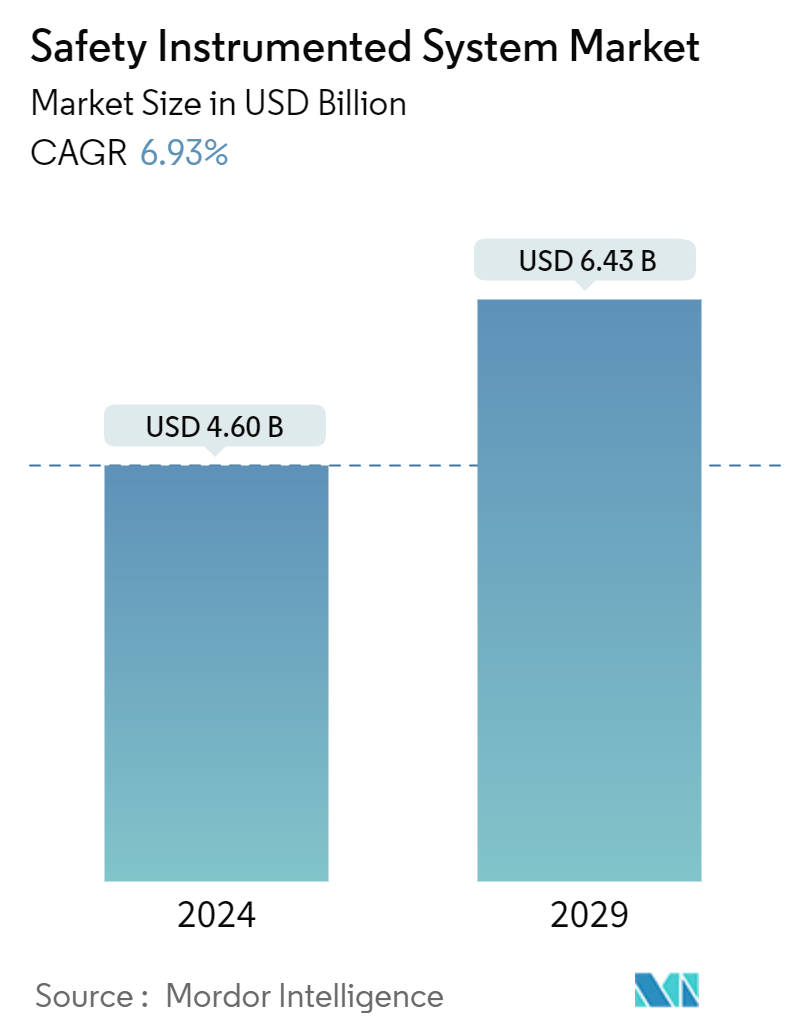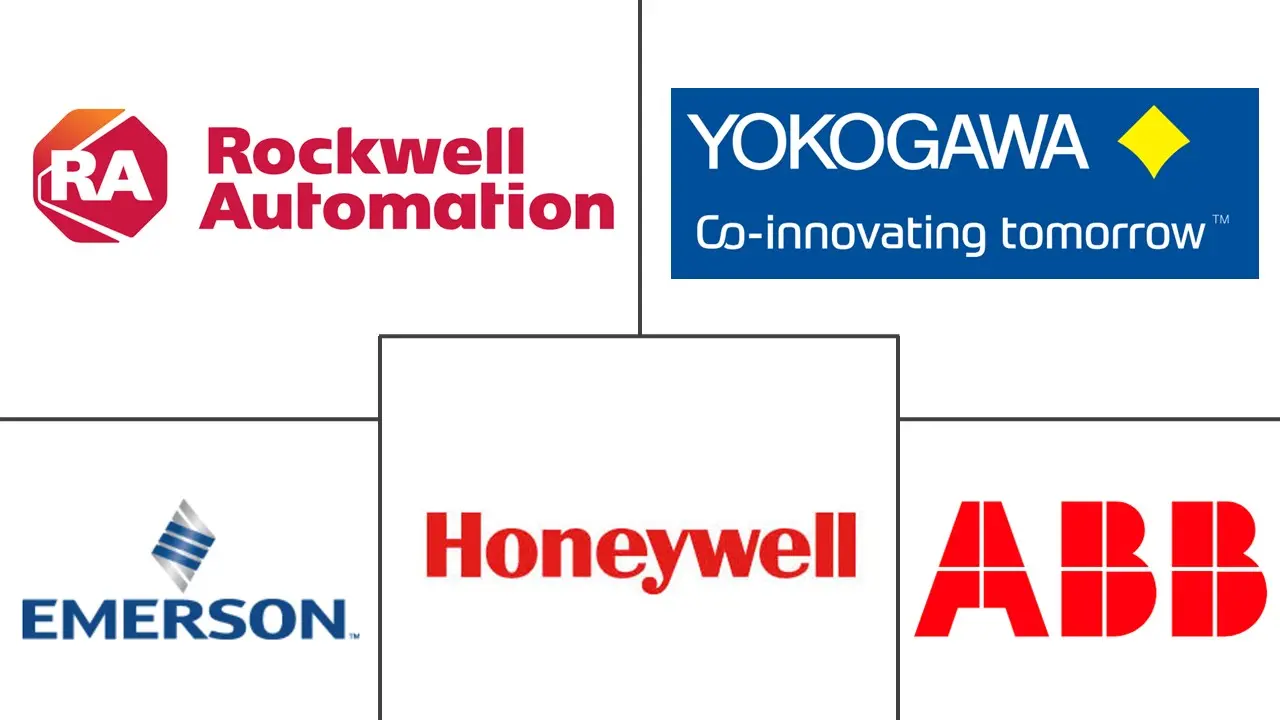Market Size of Safety Instrumented System Industry

| Study Period | 2019 - 2029 |
| Market Size (2024) | USD 4.60 Billion |
| Market Size (2029) | USD 6.43 Billion |
| CAGR (2024 - 2029) | 6.93 % |
| Fastest Growing Market | Asia-Pacific |
| Largest Market | North America |
| Market Concentration | Medium |
Major Players
*Disclaimer: Major Players sorted in no particular order |
Safety Instrumented System Market Analysis
The Safety Instrumented System Market size is estimated at USD 4.60 billion in 2024, and is expected to reach USD 6.43 billion by 2029, growing at a CAGR of 6.93% during the forecast period (2024-2029).
The widespread adoption of safety regulations and standards, coupled with increased awareness about the need for industrial safety management and competency at individual and organizational levels, has led to the rapid adoption of safety switches in manufacturing units to prevent accidents.
- In August 2023, five laborers died after inhaling a suspected poisonous gas that emanated from a tank at a food product factory in Madhya Pradesh. It was due to a lack of negligence in taking safety measures at the factory. Also, 18 workers were hospitalized after inhaling a toxic gas that leaked from a tank in a chemical factory in Gujarat, India. Such an alarming situation has emphasized the need for various end-user industries in the country to adopt high-integrity pressure protection systems.
- The industrial processes across chemicals and petrochemicals, power generation, pharmaceuticals, food and beverage, oil and gas, and other end users are closely regulated by various governing bodies to prevent sudden breakdowns and mishaps. The regulatory environment has tightened to encourage the deployment of SIS as a precautionary measure. The widespread adoption of safety regulations and standards, coupled with increased awareness about the need for industrial safety management and competency at both individual and organizational levels, has led to the rapid adoption of safety switches in manufacturing units to prevent any accidents.
- The deployment of the SIS in the oil and gas industry is driven by the strict laws and acts that are formulated to restrict catastrophic spillage and avoid environmental pollution.
- For instance, the US Oil Pollution Act, alongside Oil Spills Prevention and Preparedness Regulations, is placed to prevent such accidents. Several compliance programs, such as the On-Site Civil Inspection Procedures Rule, as contemplated by section 7 of EO 13892, ensure that reasonable administrative inspections check whether the facilities comply with environmental laws. The growing regulatory environment in various industries contributes to market growth.
- Since the onset of the Israeli-Hamas crisis, oil prices have surged by approximately 6%, with expectations of further increases. Global economists are formulating strategies to address the inflationary impact resulting from the ongoing war, which has already left a lasting mark on the global economy, causing continuous disruptions. Analysts are closely scrutinizing the trajectory of the Middle East crisis, drawing comparisons with past conflicts in the region to assess potential economic repercussions.
- According to the World Bank, an escalation in the conflict between Israel and the Palestinian militant group could trigger a significant energy shock, marking the first such occurrence in decades. These consequences stem from the aftermath of Russia's recent war with Ukraine and the persisting Middle East crisis, raising concerns of a recurrence of the oil price crisis seen in the 1970s. Consequently, the crisis is anticipated to significantly impact the Safety Instrumented Systems (SIS) sector, given that the oil and gas industry ranks among the largest end-users of SIS.
- The war is also poised to lead to higher food and energy prices, potentially intensifying economic consequences and causing a dual shock in global commodity markets. The resulting surge in oil and gas prices would have a cascading effect, elevating costs in the shipping and fertilizer sectors. This, in turn, could translate into increased prices for agricultural commodities, further influencing the growth of Safety Instrumented Systems (SIS).
Safety Instrumented System Industry Segmentation
Safety instrumented systems (SIS) are being implemented across industries to complement their process control systems to reduce the risk of accidents on the industry floor and in the operation process. There are many ways in which safety instrumentation is being deployed. Compliance with international standards, such as IEC 61508 and IEC 61511, which indicate an acceptable quality in the design and management of safety controls across industries, drives the implementation of SIS.
The safety instrumented systems market is segmented by application (emergency shutdown systems [ESD], fire and gas monitoring and control [F&GC], high integrity pressure protection systems [HIPPS], burner management systems [BMS], turbo machinery control, and other applications), end user (chemicals and petrochemicals, power generation, pharmaceutical, food and beverage, oil and gas, and other end users), and geography (North America, Europe, Asia-Pacific, Latin America, and Middle East and Africa). The report offers market forecasts and size in value (USD) for all the above segments.
| By Application | |
| Emergency Shutdown Systems (ESD) | |
| Fire and Gas Monitoring and Control (F&GC) | |
| High Integrity Pressure Protection Systems (HIPPS) | |
| Burner Management Systems (BMS) | |
| Turbo Machinery Control | |
| Other Applications |
| By End User | |
| Chemicals and Petrochemicals | |
| Power Generation | |
| Pharmaceutical | |
| Food and Beverage | |
| Oil and Gas | |
| Other End Users |
| By Geography | |
| North America | |
| Europe | |
| Asia | |
| Australia and New Zealand | |
| Latin America | |
| Middle East | |
| Africa |
Safety Instrumented System Market Size Summary
The Safety Instrumented Systems (SIS) market is poised for significant growth, driven by the increasing emphasis on industrial safety regulations and the need for enhanced safety management across various sectors. The market is experiencing a shift towards the adoption of advanced safety systems, which offer superior benefits over traditional methods, such as prolonged field life and reduced maintenance costs. This transition is particularly evident in industries like chemicals, petrochemicals, and oil and gas, where stringent regulatory frameworks and the potential for hazardous incidents necessitate the implementation of robust safety measures. The market's expansion is further supported by the rising awareness of safety standards and the critical role of SIS in preventing accidents and ensuring compliance with regulatory requirements.
The geopolitical landscape, particularly the ongoing conflicts in the Middle East, is influencing the SIS market by impacting oil prices and, consequently, the costs associated with energy and commodity markets. These developments underscore the importance of SIS in the oil and gas sector, which is one of the largest end-users of these systems. Additionally, the market is witnessing increased investment and interest in regions like Asia-Pacific, where rapid industrialization and favorable government policies are driving demand for safety instrumentation. Major players in the market, such as Siemens AG, ABB Ltd, and Schneider Electric SE, are actively expanding their global presence and leveraging strategic collaborations to enhance their market share. The continuous advancements in technology and the introduction of innovative safety solutions, such as Honeywell's lithium-ion battery safety sensors and Yokogawa's upgraded Collaborative Information Server, are further propelling the market forward, ensuring that SIS remains a critical component in maintaining safety and efficiency across various industries.
Safety Instrumented System Market Size - Table of Contents
-
1. MARKET INSIGHTS
-
1.1 Market Overview
-
1.1.1 Threat of New Entrants
-
1.1.2 Bargaining Power of Buyers
-
1.1.3 Bargaining Power of Suppliers
-
1.1.4 Threat of Substitute Products
-
1.1.5 Intensity of Competitive Rivalry
-
-
1.2 Impact of Macro Trends on the Market
-
-
2. Market SEGMENTATION
-
2.1 By Application
-
2.1.1 Emergency Shutdown Systems (ESD)
-
2.1.2 Fire and Gas Monitoring and Control (F&GC)
-
2.1.3 High Integrity Pressure Protection Systems (HIPPS)
-
2.1.4 Burner Management Systems (BMS)
-
2.1.5 Turbo Machinery Control
-
2.1.6 Other Applications
-
-
2.2 By End User
-
2.2.1 Chemicals and Petrochemicals
-
2.2.2 Power Generation
-
2.2.3 Pharmaceutical
-
2.2.4 Food and Beverage
-
2.2.5 Oil and Gas
-
2.2.6 Other End Users
-
-
2.3 By Geography
-
2.3.1 North America
-
2.3.2 Europe
-
2.3.3 Asia
-
2.3.4 Australia and New Zealand
-
2.3.5 Latin America
-
2.3.6 Middle East
-
2.3.7 Africa
-
-
Safety Instrumented System Market Size FAQs
How big is the Safety Instrumented System Market?
The Safety Instrumented System Market size is expected to reach USD 4.60 billion in 2024 and grow at a CAGR of 6.93% to reach USD 6.43 billion by 2029.
What is the current Safety Instrumented System Market size?
In 2024, the Safety Instrumented System Market size is expected to reach USD 4.60 billion.

